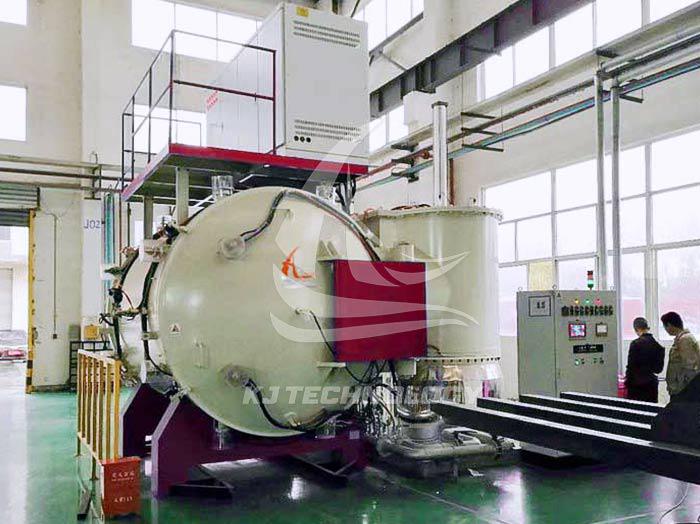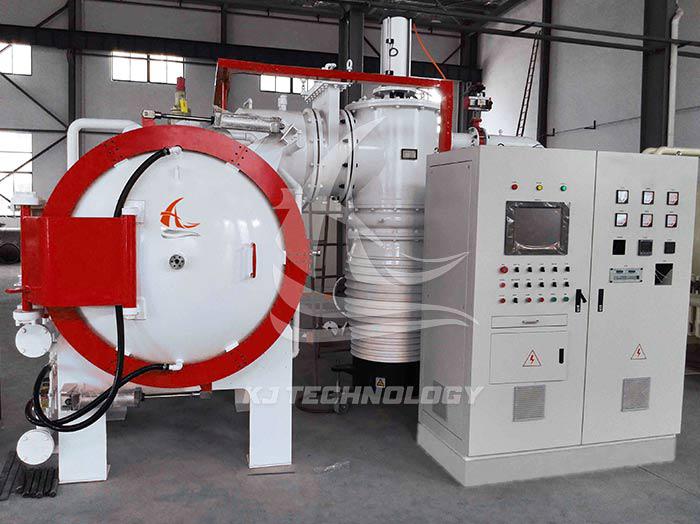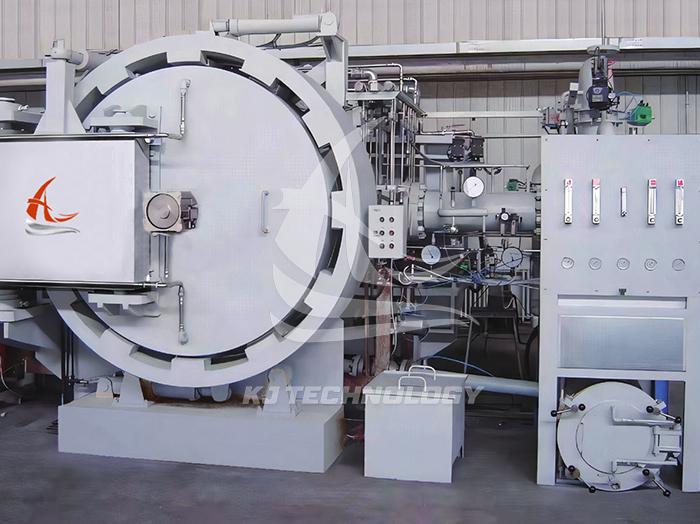aluminum vacuum brazing
 07-03-2025 Author: KJ technology
07-03-2025 Author: KJ technology
Aluminum brazing vacuum furnace is an industrial equipment used for vacuum brazing and heat treatment of various materials such as aluminum alloy, stainless steel, titanium alloy, etc. Its core principle is to melt the brazing material and connect it to the base material through precise temperature control in a vacuum environment. It has the characteristics of high precision, high cleanliness, and wide applicability, and is widely used in the manufacturing of heat exchangers in the fields of automobiles, aviation, household appliances, etc.
1. Core working principle
Removal of oxide film in vacuum environment
Aluminum and aluminum alloys are prone to forming dense oxide films on their surfaces, which hinder the wetting of brazing materials. Vacuum brazing removes oxide films through the following mechanism:
Thermal expansion difference: The thermal expansion coefficient of the oxide film is only 1/3 of that of aluminum, and the rapid expansion of aluminum during heating leads to cracking of the oxide film.
Mg steam action: When heated, Mg evaporates to form steam, which destroys the structure of the oxide film.
Chemical reaction: Mg vapor reacts with residual O ₂ and H ₂ O in the vacuum furnace to further remove the oxide film.
Melting of brazing materials and capillary filling
After the vacuum degree reaches the specified value, the furnace is heated to the melting point of the brazing material (such as 580-615 ℃) but lower than the melting point of the base material. The liquid brazing material fills the gaps between the base material through capillary action, and after cooling, metallurgical bonding is formed.
Physical and chemical processes
The diffusion reaction between liquid brazing material and solid base material enhances the strength and sealing of the joint.
2. Equipment structure and performance characteristics
Core components
Vacuum system: composed of mechanical pump, Roots pump, and diffusion pump, achieving high vacuum degree (usually ≤ 3 × 10 ⁻ ³ Pa), reducing oxidation and pollution.
Heating system: using resistance heating, graphite heating or molybdenum screen heating, with temperature uniformity within ± 3 ℃, and a maximum working temperature of 750 ℃.
Cooling system: High purity nitrogen forced cooling to prevent workpiece oxidation, and some models are equipped with water cooling devices to improve cooling efficiency.
Control system: Programmable temperature controller (such as PID control) achieves precise temperature control, equipped with oxygen analyzer for real-time monitoring of the furnace atmosphere.
Performance advantages
High cleanliness: Vacuum environment avoids the addition of gas impurities, improving welding quality.
High precision temperature control: zone heating technology ensures temperature uniformity and adapts to complex workpiece requirements.
Wide applicability: It can handle various materials such as aluminum alloy, stainless steel, titanium alloy, etc., and supports processes such as brazing, tempering, and aging.
3. Typical application scenarios
Automobile industry
Manufacturing of heat exchangers: such as aluminum radiators for automotive air conditioners, oil coolers, intercoolers, etc., which achieve efficient heat conduction and sealing through vacuum brazing.
Engine components: brazing of high-temperature components such as turbochargers and exhaust manifolds to enhance corrosion resistance and strength.
aerospace field
Lightweight structural components, such as aluminum lithium alloy body parts and titanium alloy engine blades, are brazed to meet high-strength and low-density requirements.
Thermal protection system: such as brazing of spacecraft heat shield plates to ensure reliability in extreme environments.
Home appliances and electronics industry
Refrigeration equipment: such as vacuum brazing of refrigerator condensers and air conditioning evaporators, to improve energy efficiency and lifespan.
Electronic components: precision soldering of micro components such as heat sinks and substrates to meet the requirements of miniaturization and high integration.
4. Operating standards and safety precautions
Preparation before operation
Workpiece cleaning: Before brazing, the workpiece needs to be thoroughly cleaned to remove impurities such as oil and moisture, in order to prevent pollution of the furnace environment.
Equipment inspection: Check whether the vacuum system, heating system, and cooling system are normal, confirm that the thermocouple position is accurate, and that all instruments display normally.
Operation process
Oven drying: After being shut down for more than 8 hours, the oven needs to be dried and heated to 700 ℃ under vacuum for insulation. After natural cooling to 450 ℃, the furnace door should be opened.
Brazing: Set the heating rate, heating temperature, insulation time, and vacuum degree according to the process requirements. After brazing, slowly cool down to below 450 ℃ and remove from the furnace.
Shutdown maintenance: After brazing is completed, continue vacuuming until the diffusion pump oil temperature is below 50 ℃, turn off the maintenance pump, and maintain the vacuum state inside the furnace.
Safety precautions
Vacuum degree control: Heating can only be carried out when the vacuum degree is below 3 × 10 ⁻ ³ Pa to prevent incomplete removal of oxide film and welding defects.
Emergency shutdown: In case of power outage or equipment failure, immediately close the lower angle valve and main valve to prevent oil return and oxidation.
Personnel protection: During the inflation process, no one is allowed to stand in front of the furnace body and door. When exiting the furnace, pay attention to safety to avoid burns or falling workpieces.
5. Selection and maintenance suggestions
Key selection points
Workpiece size and load-bearing capacity: Choose the furnace size and load-bearing capacity based on the maximum size and weight of the workpiece.
Temperature uniformity: Pay attention to the temperature uniformity index inside the furnace (such as ± 3 ℃) to ensure consistent welding quality.
Vacuum degree and cooling method: Select the maximum vacuum degree and cooling method (such as nitrogen cooling or water cooling) according to the process requirements.
Automation level: Prioritize equipment with automatic temperature control, automatic inflation and deflation functions to improve operational efficiency.
Maintenance
Regular cleaning: Clean the furnace, pipelines, and valves every six months to prevent impurities from accumulating and affecting performance.
Vacuum testing: Regularly test the maximum vacuum degree and pressure rise rate, record the test results for timely detection of problems.
Replacement of vulnerable parts: Pay attention to the replacement cycle of heating elements, vacuum pump oil and other vulnerable parts, and reserve spare parts in advance.
Manufacturer support: Choose suppliers who provide good after-sales service to ensure stable operation and timely maintenance of equipment.








